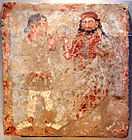Bactria
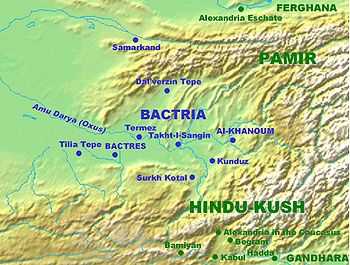
Bactria (from Βακτριανή, the Hellenized version of Old Persian Bāxtriš; Bactrian: Baktra; Persian/Pashto: باختر Bākhtar; Tajik: Бохтар; Chinese: 大夏 Dàxià; Sanskrit बाह्लीक Bahilka) is the ancient name of a historical region located south of the Amu Darya and west of Gandhara. Ancient Bactria was in present-day northern Afghanistan, between the Hindu Kush mountain range and the Amu Darya. Once Zoroastrian, this region subsequently hosted Buddhism before becoming Muslim after the arrival of the Rashiduns and Umayyads in the 7th century. Bactria was also sometimes referred to by the Greeks as Bactriana.
Geography
According to P. Leriche:[2]
Bactria, the territory of which Bactra was the capital, originally consisted of the area south of the Āmū Daryā with its string of agricultural oases dependent on water taken from the rivers of Balḵ (Bactra), Tashkurgan, Kondūz, Sar-e Pol, and Šīrīn Tagāō. This region played a major role in Central Asian history. At certain times the political limits of Bactria stretched far beyond the geographic frame of the Bactrian plain.
History
Bactria–Margiana Archaeological Complex (BMAC)

The Bactria–Margiana Archaeological Complex (BMAC, also known as the "Oxus civilization") is the modern archaeological designation for a Bronze Age culture of Central Asia, dated to ca. 2200–1700 BC, located in present day Turkmenistan, northern Afghanistan, southern Uzbekistan and western Tajikistan, centered on the upper Amu Darya (Oxus), in area covering ancient Bactria. Its sites were discovered and named by the Soviet archaeologist Viktor Sarianidi (1976). Bactria was the Greek name for Old Persian Bāxtriš (from native *Bāxçiš)[3] (named for its capital Bactra, modern Balkh), in what is now northern Afghanistan, and Margiana was the Greek name for the Persian satrapy of Margu, the capital of which was Merv, in today's Turkmenistan.
The early Greek historian Ctesias c. 400 BC (followed by Diodorus Siculus) alleged that the legendary Assyrian king Ninus had defeated a Bactrian king named Oxyartes in ca. 2140 BC, or some 1000 years before the Trojan War. Ever since the discovery of cuneiform enabled actual Assyrian records to be deciphered in the 19th century, however, historians have ascribed little value to the Greek account.
According to some writers, Bactria was the homeland of Indo-European tribes who moved south-west into Iran and into North-Western India around 2500–2000 BC. Later, it became the north province of the Persian Empire in Central Asia.[4] It was in these regions, where the fertile soil of the mountainous country is surrounded by the Turanian desert, that the prophet Zoroaster (Zarathushtra) was said to have been born and gained his first adherents. Avestan, the language of the oldest portions of the Zoroastrian Avesta, was one of the old Iranian languages, and is the oldest attested member of the Eastern Iranian branch of the Iranian language family.
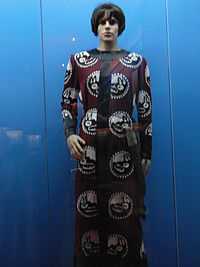 Baktrian men's wear Kafirnigan (Tajikistan). |
 Baktrian women's clothing Kafirnigan (Tajikistan). |
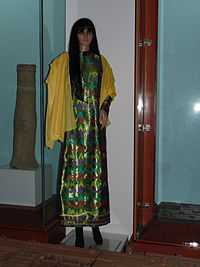 Baktrian women's clothing Kafirnigan (Tajikistan). |
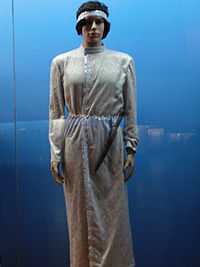 Baktrian men's wear Kafirnigan (Tajikistan). |
Cyrus the Great
It is suggested by E. Herzfeld that, prior to its annexation to the Persian Empire by Cyrus the Great in 6th century B.C., Bactria belonged to the Median empire[5] and together with Margiana formed the twelfth satrapy of Persia.[2] After Darius III had been defeated by Alexander the Great, the satrap of Bactria, Bessus attempted to organize a national resistance but was captured by other warlords and delivered to Alexander. He was then tortured and killed.[6]
Alexander the Great
 | ||||||||||||||||||||||||||||||||||||
| History of Afghanistan | ||||||||||||||||||||||||||||||||||||
|---|---|---|---|---|---|---|---|---|---|---|---|---|---|---|---|---|---|---|---|---|---|---|---|---|---|---|---|---|---|---|---|---|---|---|---|---|
| Timeline | ||||||||||||||||||||||||||||||||||||
|
Ancient
|
||||||||||||||||||||||||||||||||||||
|
Medieval
|
||||||||||||||||||||||||||||||||||||
|
Modern
|
||||||||||||||||||||||||||||||||||||
| ||||||||||||||||||||||||||||||||||||
Alexander conquered Sogdiana and Iran. However, in the south, beyond the Oxus, he met strong resistance. After two years of war and a strong insurgency campaign, Alexander managed to establish little control over Bactria. After Alexander's death, the Macedonian empire was eventually divided up between generals in Alexander's army. Bactria became a part of the Seleucid Empire, named after its founder, Seleucus I.
Seleucid Empire
The Macedonians, especially Seleucus I and his son Antiochus I, established the Seleucid Empire and founded a great many Greek towns. The Greek language became dominant for some time there.
The paradox that Greek presence was more prominent in Bactria than in areas far closer to Greece can possibly be explained by past deportations of Greeks to Bactria. For instance, during the reign of Darius I, the inhabitants of the Greek city of Barca, in Cyrenaica, were deported to Bactria for refusing to surrender assassins.[7] In addition, Xerxes also settled the "Branchidae" in Bactria; they were the descendants of Greek priests who had once lived near Didyma (western Asia Minor) and betrayed the temple to him.[8] Herodotus also records a Persian commander threatening to enslave daughters of the revolting Ionians and send them to Bactria.[9] However, these few examples are not indicative of massive deportations of Greeks to central Asia.
Greco-Bactrian Kingdom
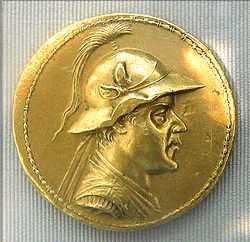

"That extremely wealthy Bactrian empire of 1000 cities (opulentissimum illud mille urbium Bactrianum imperium)"[10]
Considerable difficulties faced by the Seleucid kings and the attacks of Ptolemy II of Egypt gave Diodotus, satrap of Bactria, the opportunity to declare independence (about 255 BC) and conquer Sogdiana. He was the founder of the Greco-Bactrian Kingdom. Diodotus and his successors were able to maintain themselves against the attacks of the Seleucids—particularly from Antiochus III the Great, who was ultimately defeated by the Romans (190 BC).
The Greco-Bactrians were so powerful that they were able to expand their territory as far as India:
- "As for Bactria, a part of it lies alongside Aria towards the north, though most of it lies above Aria and to the east of it. And much of it produces everything except oil. The Greeks who caused Bactria to revolt grew so powerful on account of the fertility of the country that they became masters, not only of Bactria and beyond, but also of India, as Apollodorus of Artemita says: and more tribes were subdued by them than by Alexander...."[11]
The Greco-Bactrians used the Greek language for administrative purposes, and the local Bactrian language was also Hellenized, as suggested by its adoption of the Greek alphabet and Greek loanwords. In turn, some of these words were also borrowed by modern Pashto.[12]
Indo-Greek Kingdom

The Bactrian king Euthydemus and his son Demetrius crossed the Hindu Kush mountains and began the conquest of the Indus valley. For a short time, they wielded great power: a great Greek empire seemed to have arisen far in the East. But this empire was torn by internal dissensions and continual usurpations. When Demetrius advanced far into India one of his generals, Eucratides, made himself king of Bactria, and soon in every province there arose new usurpers, who proclaimed themselves kings and fought against each other.
Most of them we know only by their coins, a great many of which are found in Afghanistan. By these wars, the dominant position of the Greeks was undermined even more quickly than would otherwise have been the case. After Demetrius and Eucratides, the kings abandoned the Attic standard of coinage and introduced a native standard, no doubt to gain support from outside the Greek minority.
In India, this went even further. The Indo-Greek king Menander I (known as Milinda in India), recognized as a great conqueror, converted to Buddhism. His successors managed to cling to power until the last known Indo-Greek ruler, a king named Strato II, who ruled in the Punjab region until around 55 BC.[13] Other sources, however, place the end of Strato II's reign as late as 10 AD.
Sakas, Yuezhis and Sassanids

The weakness of the Greco-Bactrian empire was shown by its sudden and complete overthrow, first by the Sakas, and then by the Yuezhi (who later became known as Kushans), who had conquered Bactria by the time of the visit of the Chinese envoy Zhang Qian (circa 127 BC), who had been sent by the Han emperor to investigate lands to the west of China.[14]
Kujula Kadphises, the Guishuang xihou (or prince) of the Da Yuezhi, united the region in the early 1st century and laid the foundations for the powerful, but short-lived, Kushan Empire (1st to 3rd century AD), which was then overcome by the Sasanians from Persia.
Contacts with China

The name Daxia appears in Chinese from the 3rd century BC to designate a mythical kingdom to the West, possibly a consequence of the first contacts with the expansion of the Greco-Bactrian Kingdom, and then is used by the explorer Zhang Qian in 126 BC to designate Bactria.
The reports of Zhang Qian were put in writing in the Shiji ("Records of the Grand Historian") by Sima Qian in the 1st century BC. They describe an important urban civilization of about one million people, living in walled cities under small city kings or magistrates. Daxia was an affluent country with rich markets, trading in an incredible variety of objects, coming from as far as Southern China. By the time Zhang Qian visited Daxia, there was no longer a major king, and the Bactrian were suzerains to the nomadic Yuezhi, who were settled to the north of their territory beyond the Oxus (Amu Darya). Overall Zhang Qian depicted a rather sophisticated but demoralized people who were afraid of war.
Following these reports, the Chinese emperor Wu Di was informed of the level of sophistication of the urban civilizations of Ferghana, Bactria and Parthia, and became interested in developing commercial relationship with them:
- "The Son of Heaven on hearing all this reasoned thus: Ferghana (Dayuan) and the possessions of Bactria (Daxia) and Parthia (Anxi) are large countries, full of rare things, with a population living in fixed abodes and given to occupations somewhat identical with those of the Chinese people, but with weak armies, and placing great value on the rich produce of China" (Hanshu, Former Han History).
These contacts immediately led to the dispatch of multiple embassies from the Chinese, which helped to develop the Silk Road.
Tokharistan
Following the settlement of the Yuezhi (referred to by the Greeks as Tókharoi), the general area of Bactria came to be called Tokharistan. The territory of Tokharistan was identical with Kushan Bactria, including the areas of Surkhandarya, Southern Tajikistan and Northern Afghanistan.
The first literary mentions of Tokharistan appear at the end of the 4th century in Chinese Buddhist sources (the Vibhasa-sastra). However, the first mention of the Tókharoi appear much earlier, in the 1st century BC, when Strabo mentions that "the Tókharoi, together with the Assianis, Passianis and Sakaraulis, took part in the destruction of the Greco-Bactrian kingdom" in the second half of the 2nd century BC. Ptolemy also mentions a large Tokharian tribe in Bactria, describing the central role of the Tokharians among other tribes in Bactria. (Through an accident of naming, the term "Tocharian" now commonly refers to a branch of Indo-European languages spoken in the Tarim Basin between the 3rd and 9th centuries AD, and quite distinct from the Bactrian language spoken by the Tókharoi.)
From the 1st century AD to the 3rd century AD, Tokharistan was under the rule of the Kushans. They were followed by the Sassanids (Indo-Sassanids). Later, in the 5th century, it was controlled by the Xionites and the Hephthalites but was reconquered by the Sassanids, it was later conquered by the Arabs and then the Mongols.
Onset of Islam
Thirty years after the death of the Prophet Muhammad, the Arabs defeated the Persian Sassanids during the Rashidun Caliphate. The Muslim Umayyad Caliphate, which was founded in 661, ruled over Iran and much of the Middle East, including Bactrian lands.[15]
Advancing further the Muslims faced off with the Turk Shahis ruling in Bactria and defeated them. In 663, they attacked Bactria, which the Turki Shahis had taken from the Western Turks by this time. The Umayyad forces captured the area around Balkh, including Nava Vihara Monastery, causing the Turki Shahis to retreat to the Kabul Valley.[15]
Bactrian people
The Bactrians were the inhabitants of Bactria. Several important trade routes from India and China (including the Silk Road) passed through Bactria and, as early as the Bronze Age, this had allowed the accumulation of vast amounts of wealth by the mostly nomadic population. The first proto-urban civilization in the area arose during the 2nd millennium BC. Control of these lucrative trade routes, however, attracted foreign interest, and in the 6th century BC the Bactrians were conquered by the Persians, and in the 4th century BC by the Ancient Macedonians. These conquests marked the end of the Bactrian independence. From around 304 BC the area formed part of the Seleucid Empire, and from around 250 BC it was the centre of a Greco-Bactrian kingdom, ruled by the descendants of Greeks who had settled there following the conquest of Alexander the Great.
These people, also known in Sanskrit as Yavanas, worked in cooperation with the native Bactrian aristocracy. By the early 2nd century BC the Greco-Bactrians had created an impressive empire that stretched southwards to include northwest India. By about 135 BC, however, this kingdom had been overrun by invading Yuezhi tribes, an invasion that later brought about the rise of the powerful Kushan Empire. From this point the Bactrians tend to disappear from the historical record, a disappearance made final by the Arab invasion of the 8th century AD.
The Bactrians spoke Bactrian, a northeastern Iranian language, descended from Avestan, and most closely related to extinct Khwarezmian, modern Yaghnobi, and Ossetian. Bactrian went extinct, replaced by southeastern Iranian languages such as Pashto, Yidgha, Munji, and Ishkashmi. The Encyclopaedia Iranica states:Bactrian thus occupies an intermediary position between Pashto and Yidgha-Munji on the one hand, Sogdian, Choresmian, and Parthian on the other: it is thus in its natural and rightful place in Bactria.[16]The principal religions of the area before Islam were Zoroastrianism and Buddhism.[17] The Bactrian people are primarily the ancestors of modern-day Tajiks as well as Pashtuns.[18][19] Regarding Tajiks, the Encyclopædia Britannica states:
The Tajiks are the direct descendants of the Iranian peoples whose continuous presence in Central Asia and northern Afghanistan is attested from the middle of the 1st millennium bc. The ancestors of the Tajiks constituted the core of the ancient population of Khwārezm (Khorezm) and Bactria, which formed part of Transoxania (Sogdiana). They were included in the empires of Persia and Alexander the Great, and they intermingled with such later invaders as the Kushāns and Hepthalites in the 1st–6th centuries ad. Over the course of time, the eastern Iranian dialect that was used by the ancient Tajiks eventually gave way to Farsi, a western dialect spoken in Iran and Afghanistan.[20]
See also
- Bakhtiari people
- Dards
- Bactria–Margiana Archaeological Complex
- Bactrian Gold
- Bactrian Camel
- The Bahlikas
- Greater Khorasan
- Dalverzin Tepe
- Balkh
References
- Bernard, Paul (1994). "The Greek Kingdoms of Central Asia." In: History of civilizations of Central Asia, Volume II. The development of sedentary and nomadic civilizations: 700 B.C. to A.D. 250, pp. 99–129. Harmatta, János, ed., 1994. Paris: UNESCO Publishing.
- Beal, Samuel (trans.). Si-Yu-Ki: Buddhist Records of the Western World, by Hiuen Tsiang. Two volumes. London. 1884. Reprint: Delhi: Oriental Books Reprint Corporation, 1969.
- Beal, Samuel (trans.). The Life of Hiuen-Tsiang by the Shaman Hwui Li, with an Introduction containing an account of the Works of I-Tsing. London, 1911. Reprint: New Delhi: Munshiram Manoharlal, 1973.
- Cotterell, Arthur. From Aristotle to Zoroaster, 1998; pages 57–59. ISBN 0-684-85596-8.
- Hill, John E. 2003. "Annotated Translation of the Chapter on the Western Regions according to the Hou Hanshu." Second Draft Edition.
- Hill, John E. 2004. The Peoples of the West from the Weilüe 魏略 by Yu Huan 魚豢: A Third Century Chinese Account Composed between 239 and 265 CE. Draft annotated English translation.
- Holt, Frank Lee. (1999). Thundering Zeus: The Making of Hellenistic Bactria. Berkeley: University of California Press.(hardcover, ISBN 0-520-21140-5).
- Holt, Frank Lee. (2005). Into the Land of Bones: Alexander the Great in Afghanistan. University of California Press. ISBN 0-520-24553-9.
- Tremblay, Xavier (2007) "The Spread of Buddhism in Serindia ― Buddhism among Iranians, Tocharians and Turks before the 13th century." Xavier Tremblay. In: The Spread of Buddhism. (2007). Edited by Ann Heirman and Stephan Peter Bumbacher. Handbook of Oriental Studies. Section Eight, Central Asia. Edited by Denis Sinor and Nicola Di Cosmo. Brill, Lieden; Boston. pp. 75–129.
- Watson, Burton (trans.). "Chapter 123: The Account of Dayuan." Translated from the Shiji by Sima Qian. Records of the Grand Historian of China II (Revised Edition). Columbia University Press, 1993, pages 231–252. ISBN 0-231-08164-2 (hardback), ISBN 0-231-08167-7 (paperback).
- Watters, Thomas. On Yuan Chwang's Travels in India (A.D. 629–645). Reprint: New Delhi: Mushiram Manoharlal Publishers, 1973.
-
 Chisholm, Hugh, ed. (1911). "Bactria". Encyclopædia Britannica 3 (11th ed.). Cambridge University Press
Chisholm, Hugh, ed. (1911). "Bactria". Encyclopædia Britannica 3 (11th ed.). Cambridge University Press
Notes
- ↑ 1.0 1.1 Metropolitan Museum of Art exhibition
- ↑ 2.0 2.1 P. Leriche, "Bactria, Pre-Islamic period." Encyclopaedia Iranica, Vol. 3, 1998.
- ↑ David Testen, "Old Persian and Avestan Phonology", Phonologies of Asia and Africa, vol. II (Winona Lake, Indiana: Eisenbrauns, 1997), 583.
- ↑ Cotterell (1998), p. 59
- ↑ Herzfeld, Ernst (1968). The Persian Empire: Studies in geography and ethnography of the ancient Near East. F. Steiner. p. 344.
- ↑ Holt (2005), pp. 41–43.
- ↑ Herodotus, 4.200-204
- ↑ Strabo, 11.11.4
- ↑ Herodotus 6.9
- ↑ Justinus XLI 1.8.
- ↑ Strabo Geography, Book 11, chapter 11, section 1
- ↑ UCLA Language Materials Project: Language Profile: Pashto
- ↑ Bernard (1994), p. 126.
- ↑ Silk Road, North China C. Michael Hogan, the Megalithic Portal, 19 November 2007, ed. Andy Burnham
- ↑ 15.0 15.1 The Berzin Archives od Dr Alexander Berzin ,Historical Sketch of Buddhism and Islam in Afghanistan
- ↑ N. Sims-Williams. "Bactrian language". Encyclopaedia Iranica. Originally Published: December 15, 1988.
- ↑
- Peoples, nations and cultures, by John Haywood and Simon Hall, London 2005
- ↑ Library of Congress: Country Studies; "Tajikistan – Historical & Ethnic Background": "Contemporary Tajiks are the descendants of ancient Eastern Iranian inhabitants of Central Asia, in particular the Soghdians and the Bactrians, and possibly other groups."
- ↑ Cambridge Encyclopedia Vol. 8, pg. 2246, "Bactria - Geography, History, Tokharistan, Archaeological sites", with this quote "The Bactrians are one of the ancestral lines of the modern-day Pashtuns, Tajiks, of Central Asia."
- ↑ Tajikistan: History Britannica Online Encyclopedia
External links
- Bactrian Gold
- Livius.org: Bactria
- Batriane du nord—about the Termez region, an archeological site
- Art of the Bronze Age: Southeastern Iran, Western Central Asia, and the Indus Valley, an exhibition catalog from The Metropolitan Museum of Art (fully available online as PDF), which contains material on Bactria
